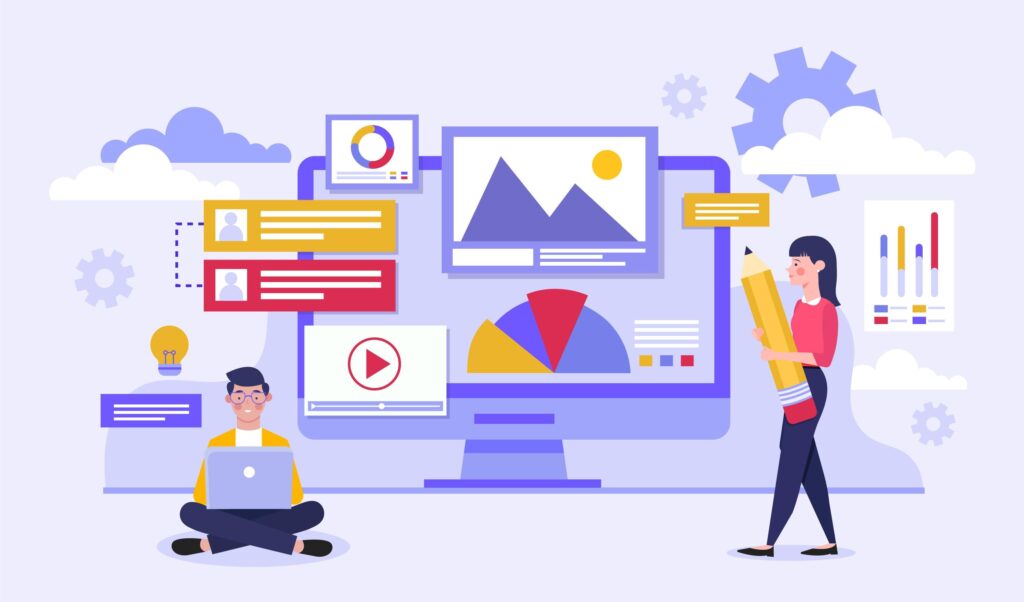When it comes to software, some programs have transformed our daily lives in profound ways. From operating systems to office suites and communication tools, certain pieces of software have become nearly indispensable. These programs have shaped how we work, communicate, and entertain ourselves.
In this blog, we’ll explore the most popular software of all time, examining its impact and why it’s become integral to our digital experience.
Let’s explore these groundbreaking applications and discover what makes them stand out.
What is the Most Popular Application Across all Software Categories?
Microsoft Windows: The Operating System That Shaped Personal Computing
Imagine starting a computer and seeing a familiar interface. That’s Microsoft Windows for you. Since its debut in 1985, Windows has been the cornerstone of personal computing. It’s not just an operating system; it’s a gateway to your digital world.
Windows started with version 1.0 and has evolved dramatically over the decades. Each new version brought improvements, making computing more accessible and powerful. From the user-friendly Windows 95 to the robust Windows 10 and 11, Microsoft has set the standard for desktop environments.
Its impact isn’t just in business but also in homes worldwide. The familiarity and functionality of Windows have made it a go-to choice for millions. Whether you’re gaming, working, or browsing, Windows likely plays a key role in your digital experience.
Android: The Mobile OS That Revolutionized Smartphones
Fast forward to 2008, and Android makes its grand entrance. Developed by Google, Android transformed the mobile landscape. This operating system is now the backbone of countless smartphones and tablets.
The beauty of Android lies in its openness. It allows manufacturers to customize their devices, offering a variety of choices. This flexibility has helped Android dominate the mobile market, giving you options to fit your preferences and budget.
Android’s influence extends beyond just phones. It powers tablets, smart TVs, and even some wearables. Its versatility ensures that you have a seamless experience across various devices. Whether you’re checking emails, playing games, or streaming videos, Android is there to enhance your mobile life.
iOS: The Sleek and Powerful Mobile Experience
In 2007, Apple introduced iOS, and it changed everything. iOS powers iPhones and iPads, delivering a polished, user-friendly experience. Its integration with Apple’s hardware creates a seamless ecosystem.
iOS is known for its intuitive interface and strong security. The App Store offers a curated selection of apps, ensuring quality and reliability. Apple’s emphasis on design and functionality makes iOS a favorite among many.
The iOS ecosystem extends beyond just smartphones and tablets. It integrates with Macs, Apple Watches, and Apple TVs, creating a cohesive user experience. If you use multiple Apple devices, iOS ensures they work together effortlessly.
Microsoft Office: The Cornerstone of Productivity Software
When it comes to productivity, Microsoft Office has been a game-changer. Launched in 1989, it’s more than just software; it’s a productivity suite. With tools like Word, Excel, and PowerPoint, it has become the standard for office work.
Microsoft Office is everywhere. Whether you’re drafting a document, analyzing data, or preparing a presentation, Office has you covered. Its features have evolved to meet the changing needs of users, making it an essential tool for professionals.
The integration of Office 365 and cloud services has modernized the suite. You can now collaborate in real time, access files from anywhere, and stay productive on the go. Office’s adaptability ensures it remains a vital part of your professional toolkit.
Google Workspace: The Modern Collaborative Powerhouse
Google Workspace, formerly known as G Suite, offers a cloud-based suite of tools. Launched in the early 2000s, it includes Google Docs, Sheets, and Slides. These tools have become central to many workplaces and educational settings.
What sets Google Workspace apart is its emphasis on collaboration. You can work with others in real time, making teamwork more efficient. This feature is particularly valuable for remote teams and dynamic work environments.
Google Workspace is also known for its simplicity and ease of use. The web-based nature of its tools means you can access them from any device with an internet connection. This flexibility supports a modern, mobile-centric work style.
Google Chrome: The Browser That Redefined Speed
Released in 2008, Google Chrome redefined web browsing. It quickly gained popularity due to its speed, simplicity, and security. Chrome’s minimalist design makes it easy to use while packing powerful features.
One of Chrome’s standout features is its speed. It loads pages quickly and efficiently, enhancing your browsing experience. Chrome’s robust security features also protect you from online threats, making it a reliable choice for everyday browsing.
Chrome’s impact extends beyond just speed. It introduced features like the Omnibox, which combines the address and search bars. This innovation streamlined the browsing experience, making it faster and more intuitive.
Internet Explorer: The Browser of the Early Web Era
Before Chrome, there was Internet Explorer. Microsoft’s browser was a dominant force in the early 2000s. It played a significant role in shaping the early web experience.
Internet Explorer was integral to the development of web standards and technologies. Its popularity helped drive the adoption of the Internet in homes and businesses. Although it has largely been replaced by Microsoft Edge, its impact on the web is undeniable.
While Internet Explorer faced criticism for its performance and security issues, it paved the way for future browsers. Its legacy is a reminder of how technology evolves and how new innovations build on past achievements.
WhatsApp: The Messaging App That Changed Communication
In 2014, Facebook acquired WhatsApp, and it became a global phenomenon. This messaging app offers a simple, secure way to communicate with others. Its widespread use makes it a key tool in personal and professional communication.
WhatsApp’s appeal lies in its simplicity and functionality. You can send texts, make calls, and share media with ease. Its end-to-end encryption ensures that your conversations remain private and secure.
WhatsApp has also evolved to include features like group chats and status updates. These additions enhance the app’s functionality, making it a versatile communication tool. Its global reach means you can stay connected with people around the world effortlessly.
Microsoft Teams: The Collaboration Tool for the Modern Workplace
Microsoft Teams has become a cornerstone of remote work and collaboration. Launched as part of Office 365, it offers a platform for communication, collaboration, and project management. Its integration with other Microsoft tools enhances its utility.
Teams supports chat, video conferencing, and file sharing. This comprehensive approach makes it easier to manage projects and communicate with colleagues. The ability to create channels for different topics and teams streamlines workflows and keeps discussions organized.
As remote work becomes more prevalent, Microsoft Teams provides a valuable solution for staying connected. Its features support various work styles, from quick messages to detailed project discussions, making it an essential tool for modern workplaces.
VLC Media Player: The Versatile Media Solution
VLC Media Player is a favorite for many due to its versatility. Released in 2001, it supports a wide range of file formats, making it a go-to media player. Its open-source software nature means it’s constantly updated by a community of developers.
VLC’s ability to handle almost any media format sets it apart. You can play videos and audio files without worrying about compatibility issues. Its simple interface and robust performance make it an excellent choice for both casual and advanced users.
The player also includes features like streaming and subtitle support. These additions enhance its functionality, allowing you to enjoy media in various ways. VLC’s adaptability ensures it remains a valuable tool for media consumption.
Visual Studio: The IDE for Developers
Visual Studio, released in 1997, is a key tool for software developers. It offers a comprehensive integrated development environment (IDE) for building applications. Its robust features support various programming languages and development needs.
Developers appreciate Visual Studio for its powerful debugging tools and code editors. It simplifies complex tasks and enhances productivity. The IDE’s integration with version control and other development tools streamlines the development process.
Visual Studio’s continuous updates and improvements ensure it meets the evolving needs of developers. Whether you’re working on a small project or a large enterprise application, Visual Studio provides the tools you need to succeed.
Eclipse: The Open-Source IDE Revolution
Eclipse, first released in 2001, is another popular software IDE, particularly for Java development. Its open-source nature allows for extensive customization and community contributions. Eclipse supports a range of programming languages and development tools.
Eclipse’s modular architecture enables developers to add plugins and extensions. This flexibility makes it suitable for various development environments and tasks. Its strong support for Java and other languages has made it a popular choice in the developer community.
The IDE’s focus on extensibility and community involvement has fostered innovation. Eclipse’s ongoing development ensures it remains a relevant and powerful tool for software development.
Adobe Photoshop: The Gold Standard in Image Editing
Adobe Photoshop, released in 1988, is synonymous with image editing. It has become the industry standard for graphic design and photo manipulation. Its extensive features and capabilities make it a powerful tool for creative professionals.
Photoshop’s tools allow for detailed image editing, from simple adjustments to complex manipulations. Its layers and filters provide endless possibilities for creativity. The software’s impact on design and photography is immense, setting the benchmark for other image editing programs.
Photoshop’s integration with other Adobe products and its support for various file formats further enhance its utility. Whether you’re designing a logo, editing a photo, or creating digital art, Photoshop remains an essential tool in your creative toolkit.
Adobe Illustrator: The Vector Graphics Master
Adobe Illustrator, launched in 1987, specializes in vector graphics. It’s the go-to tool for creating scalable illustrations and designs. Its precision and versatility make it a favorite among graphic designers.
Illustrator’s vector-based approach allows for scalable designs without losing quality. This feature is crucial for creating logos, icons, and illustrations that need to be resized. The software’s tools and features support a range of design needs, from print to digital media.
The integration of Illustrator with other Adobe Creative Cloud apps enhances its functionality. This connectivity ensures a seamless workflow for designers, making it easier to move between different projects and tasks.
Conclusion
These software products have shaped our digital landscape in great ways. From operating systems that power our devices to applications that enhance productivity and creativity, each piece of software plays a crucial role. Understanding their impact helps you appreciate the tools you use every day and the innovations that drive technology forward.
Whether you’re using Microsoft Windows for work, Android or iOS on your mobile device, or Adobe Photoshop for creative projects, these software solutions have become integral to modern life. Their popularity continues to evolve, shaping how we interact with technology and each other.





